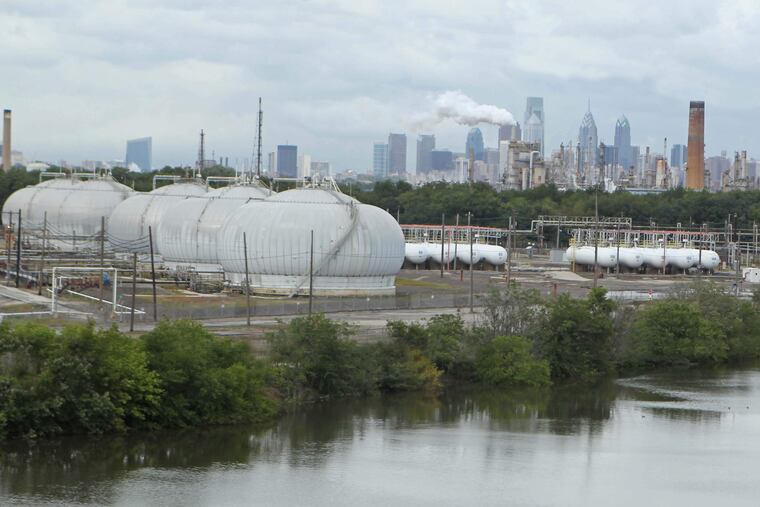Hilco’s cleanup plan for South Philly refinery is a lost opportunity | Opinion
Where was the public process to help inform Hilco’s plan? Have the communities who lived for generations in the toxic shadow of the refinery been heard?

In the blink of an eye, the vast, 1,400-acre former oil refinery on the Lower Schuylkill — stretching over more than two square miles from below Grays Ferry to Girard Point — went from processing and storing gasoline to one poised to be an extensive logistics hub for companies like Amazon, Walmart, FedEx, and others.
Changing the site’s use is a good thing. A sea of gargantuan warehouses, as currently envisioned, is another.
Hilco Redevelopment Partners has swept into Philadelphia as a knight errant to help clean up and repurpose the bankrupt oil fields. Their proposal would not allow future residential use of the property, calling for the creation of an “exposure barrier” to cover — not remove — extensive pollutants within the existing soil and groundwater on the property.
Hilco’s conceptual master plan calls for the entire site to be elevated above flood level, as a significant portion is projected to be impacted by sea-level rise and flooding due to climate change over the next 80 years. They also plan to build up to 11 massive warehouses of one million square feet each, sprawling over more than 58 football fields apiece.
What’s wrong with this picture?
At 1,400 acres, the former refinery is larger than all of Center City, the original City of Philadelphia planned in 1682 by William Penn that stretches river to river and from Vine Street to South Street. You can pack a lot into 1,400 acres in what could easily be a whole new section of the city.
Located strategically between the bustling job hubs of Center City, University City, Philadelphia International Airport, and the Navy Yard, the site has enormous potential to be much more than just a faceless warehouse farm.
Where was the public process to help inform Hilco’s plan? Have the communities who lived for generations in the toxic shadow of the refinery been heard? What benefits will accrue to the public?
We just spent the better part of two decades valiantly extending the Schuylkill River Trail from the Art Museum to Bartram’s Garden — actually building whole sections of the trail over water. Where are the cries to continue that effort to the mouth of the Schuylkill at Girard Point?
Did we not mount a first-rate effort to entice Amazon to build a new headquarters in Philadelphia? Where are the cries to think of this parcel as a long-term, strategic extension of the city and its neighborhoods, business districts, parks, and trails?
Hilco is taking the easy way out, maximizing their asset and, in return, giving nothing of significance back to the city and surrounding communities.
Warehouses are a human dead zone. Aside from the eerie luminescence of trucks’ rear taillights at night, the effect of this development will be a significant lost opportunity for Philadelphia.
I am beginning to feel nostalgia for the dystopian car crusher that graced the foot of the Platt Bridge for generations.
» READ MORE: Newly revealed restrictions challenge redevelopment of bankrupt Philly refinery’s land
The city and Hilco should be creating a master plan for this site that can evolve over the years with warehouse use at the outset. We could decide how the site would connect back into adjoining neighborhoods, what ecological role it should play, how it would connect to transit, and how we could create a gateway to the city from the airport at Girard Point.
Philadelphia has an illustrious history of long-term planning. Penn’s plan took more than 150 years to fill in. The Benjamin Franklin Parkway is continually evolving, and Fairmount Park, the 4,000-acre working landscape created in the mid-1800s to secure the city’s water supply, still provides water along with refuge and respite to this day.
One thing we learned during the early days of the pandemic was the need to be flexible, and for connected public spaces to serve the large swaths of the city that do not have access to parks and open spaces. This site could play a valuable role in future crises.
What is Hilco’s vision for the future?
We seem to have sold our patrimony for a handful of beans — to get someone to pick up the environmental liability and add 10,000 jobs to Philadelphia.
Philadelphia can do much better.
Harris M. Steinberg is the executive director of the Lindy Institute for Urban Innovation at Drexel University. He led the 2006-07 public process to create the civic vision now guiding the development of the Central Delaware Riverfront.